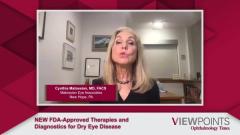
Anti-Inflammatory Therapies for Dry Eye Disease
Kelly K. Nichols, OD, MPH, PhD, discusses various anti-inflammatory treatment options for dry eye disease (DED), such as cyclosporine, lifitegrast, and varenicline. In addition, Cynthia Matossian, MD, FACS, provides an overview of the mechanism of action of lifitegrast and how it differs from cyclosporine.
Episodes in this series

Transcript
Bill B. Trattler, MD: Maybe we just talk about, in general, just all the various anti-inflammatory technologies that we have available to us. I'm going to ask Dr Nichols because, you know, we have a few different options. We have cyclosporine, we have lifitegrast, we have obviously topical steroids, and Tyrvaya or varenicline, I hope I said that right. As everyone knows here, I'm not the best at pronouncing names. So, Dr. Nichols, maybe share kind of how these and anti-inflammatory treatments are similar or different and I guess an overview of those products’ product.
Kelly K. Nichols, OD, MPH, PhD: Great. And I will have a question for all the panelists too at the end, because if you don't have the ability or you haven't done in-office procedures, then your approach might be different relative to some of these other therapies that Bill just mentioned. So, you know, it is interesting, depending on where you are, I know if you have, I know what I would do if I had everything in my office versus if you only have yourself and your slit lamp. So having said that, you know, inflammation is one of the body's ways in which it can respond to insult or injury or irritation. And so, you're going to have inflammation with ocular surface conditions regardless. In some cases, it's not going to be obvious, and in others it's going to be much more obvious. And in some instances, there's going to be associated factors where they have inflammatory diseases that go along with what you're seeing on the ocular surface. So, your choices may be different depending on what else is going on. We have cyclosporine, [its] been around for the longest of all of these medications. It had like at least a 15-year head start on lifitegrast. So, we tried it, we used it. It was all that it was available. And originally when cyclosporine came out, I think a lot of doctors saved it for the worst dry patients because they really didn't know how it fit into the algorithm and what they should do. And then there were a number of doctors actually who tried it for a short period of time or patients, and then patients stopped for whatever reason, they didn't get the full effect or maybe they didn't realize they got some effect. And so, they quit. When we are seeing patients for clinical trials now, most of the time they've tried cyclosporine at some point in the past, but when they describe how they tried it, it can be like they just they say, "well, I did try it." Well, how long did you try it? "Well, I don't know." You know, you ask them if they refilled their prescription to find out if they really tried it. And most of the time they don't. And I would say that's even sort of true with lifitegrast, especially if the patient has symptoms of the negative side effects, you know, whether they have blurry vision, or with cyclosporine, if they have a lot of stinging. Now there are ways that you can coach a patient around those if you really do feel like having a chronic anti-inflammatory therapy works, and they do, they just do take some time to kick in based on their mechanism of action. They're all slightly different. Then of course, we talked about steroids just a moment ago, which give you that first initial burst acute help. And then there's, I'll just call it Tyrvaya as well, because Bill I'm with you, I'm the camp of can't pronounce any of the new names. There's a few that were just approved, that we'll talk about later, and I'm like, wait a minute, how do you say that? What do we to do? But yeah, so I don't know that I'd put that in the controlling inflammation category because it is sort of like an internal, self-regulated, artificial tear that your own body makes. So, I guess it can help calm any inflammation on the ocular surface because it's helping to sort of give some lubrication, perhaps, that might have been what was part of the problem, in terms of causing inflammation. But you do have to get to the root of it. And these can all help in their own ways, but they don't solve the problem in most cases.
Bill B. Trattler, MD: That is a great overview. That actually was lovely to hear because I think it really helps us kind of set the framework for everything. I think, you know, obviously the two main categories, cyclosporine and lifitegrast, we've had them both now a little while, and you know cyclosporine was first. I'm going to ask Dr. Matossian, maybe you should explain the mechanism of lifitegrast and give an overall view. Because I think even though it's newer and it's been around for a bit, I think it's always helpful to kind of review that.
Cynthia Matossian, MD, FACS: Well, I will try to make it as simple as I can, but it is complex. In essence, Xiidra or lifitegrast blocks LFA-1. So, what is LFA-1? LFA one is a surface protein found on the surface of T-cells. So, T-cells are just floating about regularly, looking to be invited to an inflammatory site. When the surface is stressed, there's something called ICAM-1s that are overexpressed. ICAM-1s invite or recruit T-cells. The way a T-cell docks onto the ICAM-1 is by its LFA-1. So, it's kind of how they come together. So lifitegrast blocks that ability of the LFA-1 to dock with the ICAM-1, and it's only through the docking that the T-cell is then activated and then it releases all the pro-inflammatory cytokines, and more recruitment of T-cells happens. So, by blocking it, not only inactive T-cells, but active T-cells as well, it kind of reduces that perpetual inflammatory cycle on the surface of the eye.
Bill B. Trattler, MD: That's a beautiful explanation. That was fantastic. I definitely could not have explained as concisely as you did, Dr Matossian, that was beautiful.
Transcript is AI-generated and edited for clarity and readability.
Newsletter
Don’t miss out—get Ophthalmology Times updates on the latest clinical advancements and expert interviews, straight to your inbox.



























































